Research Results
1. Novel strategy for engineering root nodule symbiosis into important crops for more sustainable agri-food systems 
Legume plants do not depend on externally supplied nitrogen, owing to their ability to form a symbiosis with nitrogen-fixing bacteria. The plants recognize the nitrogen-fixing bacteria and allow them to colonize by forming nodules. It is not known how receptors work together in signalling complexes. Researchers, led by Henriette Rübsam at Aarhus University, Denmark, have developed an approach in which they attach a green fluorescent protein (GFP) to one nod factor receptor (NFR1) and a nanobody that binds the GFP to another receptor (NFR5). To the surprise of the researchers, just bringing the receptors together by nanosphere binding was enough to start knot formation. They also tested other receptors, but nothing happened, so they infer that NFR1 and NFR5 must form a complex to start symbiotic signalling.
In the long term, researchers want to create a symbiosis between cereal root nodules to reduce the use of nitrogen fertilizers, which have a huge CO2 footprint, and thus provide stable yields for smallholders with limited access to commercial fertilizers. “We have a rather wild idea that existing barley receptors can trigger nodulation in the pod,” explains Simona Radutoiu, one of the team members. They tested the signalling capacity of the barley receptors by pulling them together with nanobodies, and they were able to show that the combination of the two receptors (receptor-like protein kinase) RLK1 and RLK10 leads to the formation of nodes in the lotus. This was completely unexpected and very promising, as it could be an important step on the way to designing crops for symbiosis with nitrogen-fixing bacteria. The new technique can now be applied to study other important receptor systems.
Access the abstract at https://phys.org/news/2023-01-strategy-root-nodule-symbiosis-important.html?utm_source=nwletter&utm_medium=email&utm_campaign=daily-nwletter
2. Inexpensive methods identified to detect the impact of drought and for breeding drought-tolerant crop plants
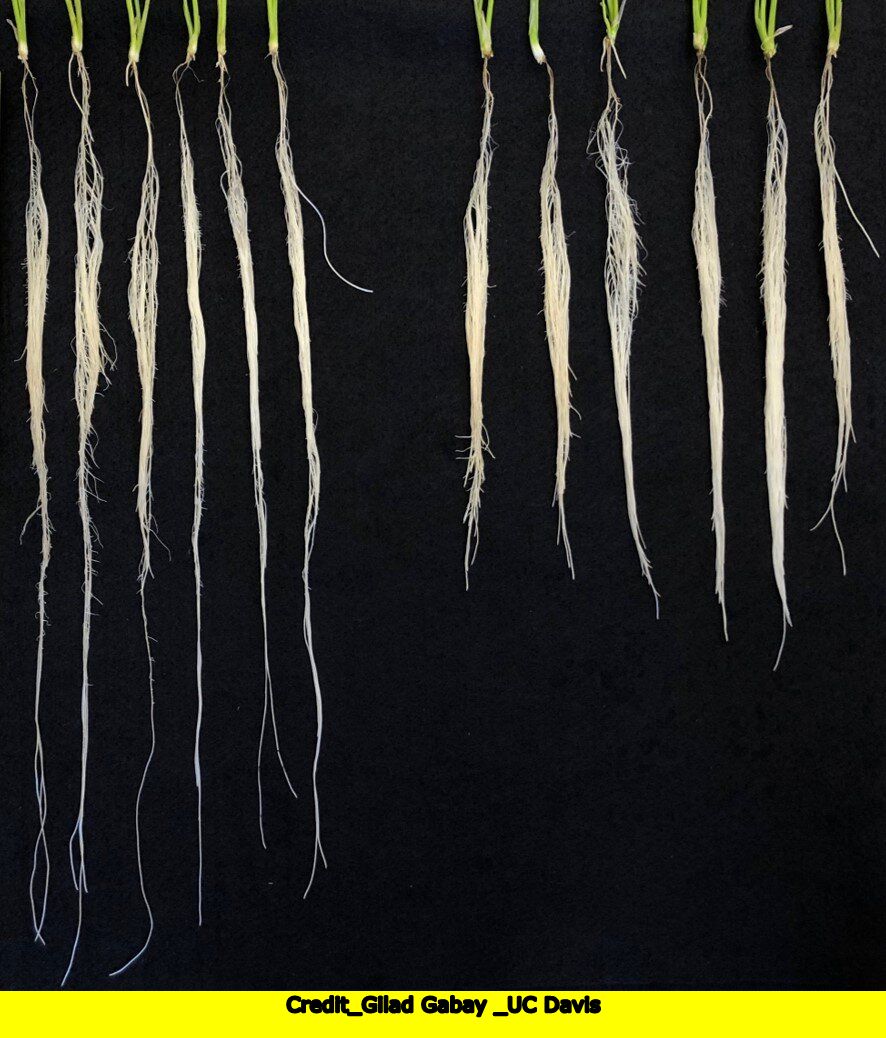
Climate change is aggravating the impact of droughts on all plant ecosystems worldwide. Before any effort is made to develop drought-tolerant genotypes, it is important to develop simple and inexpensive tools to detect the impact of the drought on the crop plant(s). Although new tools have been developed to detect and assess drought stress in plants—transcriptomic or metabolomic technologies, etc.—they are still difficult to apply in natural ecosystems, especially in remote areas and in developing countries. Sergi Munné-Bosch and Sabina Villadangos from the University of Barcelona, Spain, present a set of techniques that enable researchers to detect and monitor drought stress in plants in a cheap, easy, and quick way. Any simple laboratory could analyse different parameters on growth rates, leaf water content, pigments, and leaf viability using the tetrazolium test, an organic heterocyclic compound that has traditionally been used in plant physiology studies and could then determine the effect of drought on plants.
Sabina and Sergi, along with other colleagues, have revived the simple tetrazolium test, which is based on the ability of live tissues to reduce a colourless salt, 2,3,5-triphenyl tetrazolium chloride (TTC), into the red compound, formazan. It is useful for both seed viability tests and tissue damage assessment. This study contributes to a better understanding of the plant’s response to drought in the context of climate change.
For long, strong and deep root systems have been associated with the plant’s ability to reach water sources that may not be available to shallow-rooted plants. After understanding the effect of drought on plants, researchers led by Guillermo Santa-María at the National University of San Martín, Buenos Aires, Argentina, and Jorge Dubcovsky at the University of California, Davis, USA, report dosage differences in a cluster of monocot-specific 12-OXOPHYTODIENOATE REDUCTASE genes from subfamily III (OPRIII) modulate key differences in wheat root architecture, which are associated with grain yield under water-limited conditions. They conclude that OPRIII genes provide a useful entry point to engineer root architecture in wheat and other cereals. The right number of copies of a set of genes can stimulate longer root growth, allowing wheat plants to draw water from deeper sources. Knowing the right combination of genes enables scientists to look for wheat varieties with these responses for farmers to grow in low-lying environments.
Access the full paper at https://www.nature.com/articles/s41467-023-36248-y
3. Study sheds light on the specificity of root exudate types for soil organic carbon decomposition

Soil organic carbon is critical for climate regulation and ecosystem stability. Its decomposition can be significantly influenced by plant root exudates via the priming effect. However, there is still a lack of understanding of how specific compounds of root exudates influence soil carbon decomposition via the priming effect, and the overall pattern of these priming effects remains unexplored. A research team, led by the Weixin Cheng University of California, Santa Cruz, USA, performed a meta-analysis of 104 publications to synthesize common initiation reactions of substitution reactions in root exudates (e.g., simple sugars, low molecular weight organic acids, amino acids, and phenolics), and to investigate their regulators. They found that overall, the addition of root fluid replacements significantly stimulated microbial biomass C breakdown, enzyme activity, and soil C breakdown by an average of 27%, 28%, and 39%, thus showing a positive priming effect.
The researchers found clear differences between the magnitude of priming effects induced by root exudate substitutes and regulators. Amino acids produced the greatest cracking effect, followed by simple sugars, low molecular weight organic acids, and phenols, probably because amino acids provided a source of nitrogen that could contribute to the priming effect by promoting microbial growth. These results highlight the importance of root cross-species specificity with multiple mechanisms, leading to the priming effect. Future studies should conduct long-term experiments with continuous addition of mixed compounds to gain insight into how changes in root fluids modulate soil C decay through a priming effect. They found different regulators of the priming effect between simple sugars and low molecular weight organic acids.
Access the abstract at https://www.sciencedirect.com/science/article/abs/pii/S0038071723000172?via%3Dihub
4. Research suggests that crops have different potentials for protein extraction in biorefining
To meet environmental and climate concerns in the food supply, we must look for new sustainable protein sources with low environmental impact, and many researchers are looking for solutions in this regard. In one such effort, Henrik Thers and Jørgen Eriksen 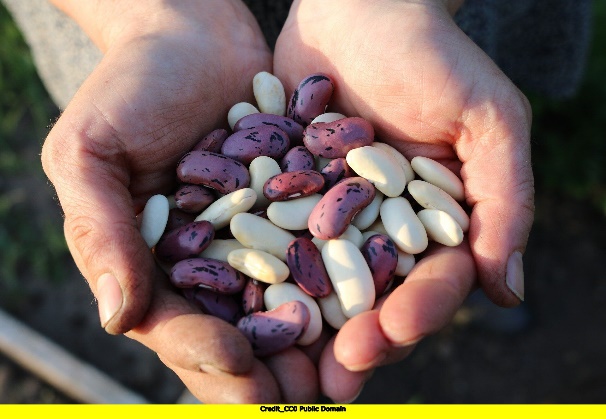 at Aarhus University, Tjele, Denmark, studied two nitrogen-fertilized grasses and three vegetables to find the optimal green biomass for protein recovery. Using a method to estimate the protein extraction potential of green crops developed by them, the researchers were able to find the protein potential of a crop in the future without it having to go through a biorefinery.
at Aarhus University, Tjele, Denmark, studied two nitrogen-fertilized grasses and three vegetables to find the optimal green biomass for protein recovery. Using a method to estimate the protein extraction potential of green crops developed by them, the researchers were able to find the protein potential of a crop in the future without it having to go through a biorefinery.
“We measured yields for two years, and just looking at the yield, it’s hard to beat the grasses, but we also looked at crude protein and the legume dry matter is slightly higher. That means if you look at protein per hectare, it is a ratio of herbs to vegetables,” says Henrik Thers. The result of red clover is quite variable between the two years, while alfalfa is at a stable level with the most fertilized grasses in terms of crude protein. Researchers used the Cornell Net Carbohydrate and Protein System (CNCPS) method to study how much protein can be extracted once in a biorefinery. It turns out that the difference is mainly between grasses and legumes because legumes contain most of the protein that can be extracted in a biorefinery. The results revealed that the entire season needs attention for optimization and not only the first cut, since both CP yields and quality peaks in different cuts across the five species and 2 years.
Access the abstract at https://onlinelibrary.wiley.com/doi/10.1002/jsfa.11722
5. Reference epigenome reveals how transcription and chromatin status changes in wheat embryogenesis
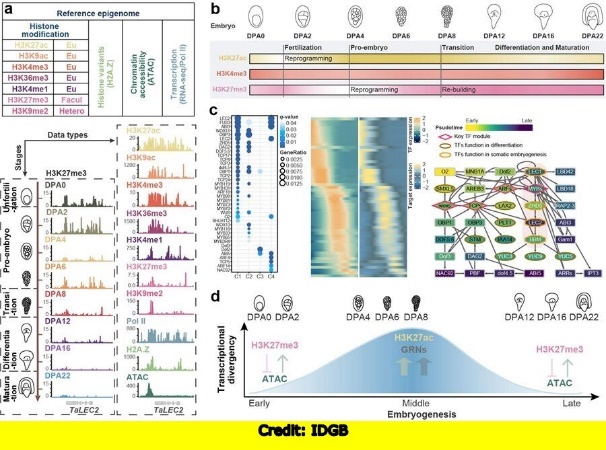
Embryogenesis is one of the most important processes in both animals and plants. Amazingly, an egg from a single mother can develop into a multi-layered body in just a few weeks after fertilization. Cell fate transition is largely determined by the expression of associated genes and the epigenetic state, which can influence gene expression. There are conserved and distinguishable features in the cellular process of animal and plant embryogenesis. Although many studies have been published on embryogenesis in animals, they are rare in plants.
A research team, led by Professor Xiao Jun at the Chinese Academy of Sciences, Beijing, focused on allohexaploid wheat and compiled a reference epigenome for wheat embryogenesis. A comparative epigenome profiled the spatial dynamics of transcription and chromatin during embryonic development and provided clues to the regulatory mechanisms underlying cooperation and conflict between hexaploid subgenomes. According to their latest study, the transcriptional and chromatin state of the wheat embryo changed dramatically after fertilization. Chromatin accessibility and H3K27ac modification (Note: epigenome includes seven histone modifications: H3K4me1, H3K4me3, H3K9ac, H3K9me2, H3K27ac, H3K27me3, and H3K36me3) were enhanced during mid-stage embryogenesis in wheat, creating a permissive chromatin environment. In general, the chromatin space condensed in early and late embryogenesis, but was available in mid-embryogenesis in wheat. This work provides an unprecedented epigenomic resource for wheat embryo research, which may facilitate the functional investigation of key genes during embryogenesis, particularly in the zygotic genome activation (ZGA).
Access the full paper at https://genomebiology.biomedcentral.com/articles/10.1186/s13059-022-02844-2
6. Study stresses the need for grassroots-level involvement in India’s biodiversity conservation effort
Biodiversity conservation and human well-being are closely linked. However, the mismatch between the planning and implementation of these two main goals has exacerbated biodiversity loss, and ecosystem service degradation, and thus affected the quality of human life. At the COP15 biodiversity conference in November last year, while India 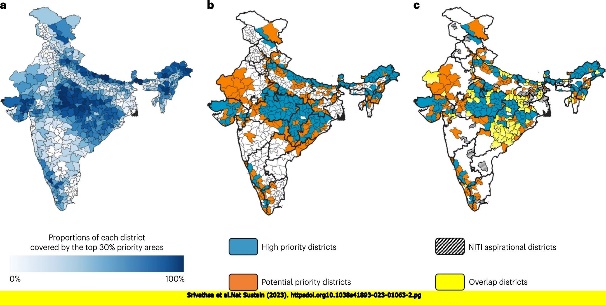 refrained from agreeing on regional targets, it urged the world to address biodiversity issues through a holistic “ecosystem-based” approach (see https://www.orfonline.org/expert-speak/indias-stance-on-the-new-global-biodiversity-framework/). This requires a rigorous assessment and understanding of ecosystem- and landscape-level conservation planning, rationally combining land allocation and conservation with the co-production of ecosystem services. Scientists in India have proposed a new type of conservation that protects local communities and biodiversity, which they call “landscape-wide conservation.”
refrained from agreeing on regional targets, it urged the world to address biodiversity issues through a holistic “ecosystem-based” approach (see https://www.orfonline.org/expert-speak/indias-stance-on-the-new-global-biodiversity-framework/). This requires a rigorous assessment and understanding of ecosystem- and landscape-level conservation planning, rationally combining land allocation and conservation with the co-production of ecosystem services. Scientists in India have proposed a new type of conservation that protects local communities and biodiversity, which they call “landscape-wide conservation.”
Arjun Srivathsa and colleagues at the Tata Institute of Fundamental Research (TIFR) in Bangalore, India, have called for a “transformation” of conservation through biodiversity conservation management and human efforts; they also indicate that regions that offer this duality have been identified. To understand biodiversity, the study delineated 338 regions, which play a key role in conserving India’s biodiversity and ecosystem services. Of these, the researchers have classified 169 areas as “highest priority” areas where habitat types, biodiversity, and ecosystem services were currently at optimal levels and covered a large area of land regionally. This approach aims to link biodiversity to ecosystem “services,” and it will only succeed if the beneficiaries of ecological restoration and those otherwise affected are considered in policy and implementation, the study says, indicating the need for grassroots-level planning and implementation. At last year’s COP15 UN Conference on Biological Diversity, 196 countries agreed on a global mission to halt and reverse biodiversity loss by 2030. “These are commitments that India has already made. We are just guiding what priorities to set, so that people and biodiversity benefit in the long term,” said Ramakrishnan, who was involved in the study.
Access the full paper at https://www.nature.com/articles/s41893-023-01063-2
Potential Crops/Technologies/Concepts
1. Yams benefit from banana ‘paper’ cocoon
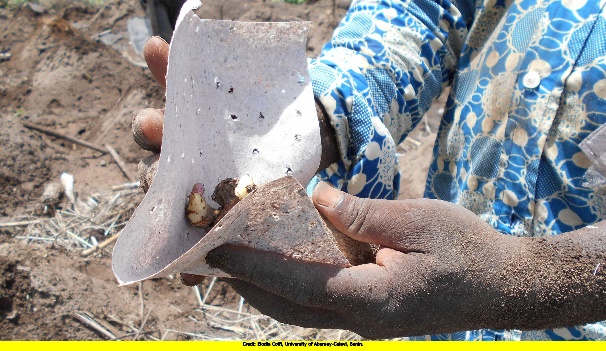 In general, smart agriculture is linked with the use of modern technologies and devices. However, in many countries where such systems cannot yet be implemented, the focus must be on developing simpler alternatives that integrate with traditional practices and contribute to sustainable food production. Among the various tubers and root crops, yams (Dioscorea rotundata and D. alata) are highly valued in West Africa, influencing the economic fortunes of millions of smallholders. The yield and quality of the yam harvest are determined by various climatic, cultural, and edaphic factors. More importantly, 17-50% of the crop is lost each year owing to plant parasitic nematodes (PPN). Wrapping yam seeds in biodegradable paper made from a mixture of banana plant parts and recycled cardboard boxes dramatically increased yam size and yield in trials in Benin, Africa, primarily from reduced PPN infection.
In general, smart agriculture is linked with the use of modern technologies and devices. However, in many countries where such systems cannot yet be implemented, the focus must be on developing simpler alternatives that integrate with traditional practices and contribute to sustainable food production. Among the various tubers and root crops, yams (Dioscorea rotundata and D. alata) are highly valued in West Africa, influencing the economic fortunes of millions of smallholders. The yield and quality of the yam harvest are determined by various climatic, cultural, and edaphic factors. More importantly, 17-50% of the crop is lost each year owing to plant parasitic nematodes (PPN). Wrapping yam seeds in biodegradable paper made from a mixture of banana plant parts and recycled cardboard boxes dramatically increased yam size and yield in trials in Benin, Africa, primarily from reduced PPN infection.
This study was conducted by a team led by Saad Khan and Charles Opperman from North Carolina State University in the United States. “We started this method of making paper in the laboratory, found out how the paper works, took it to the field and found that it not only helps yam production but also improves the quality of yam in storage,” said Saad Khan. A paper cutter is used to cut the paper into small pieces that can be wrapped around the yam seeds, which are then planted in these lands. In field trials designed to test the effectiveness of banana paper, researchers planted yam seeds wrapped in banana paper, the banana paper containing a low dose of abamectin, and no banana paper wrapper. Abamectin-impregnated banana paper provided the best protection against dry rot and cracking, followed by banana paper alone (Note: Abamectin is an insecticide and anthelmintic). Significant reductions in post-harvest tuber weight loss and cracking, value, nutrition, and stakeholder preference for wrapping and plant handling were observed after 3 and 5 months of storage, demonstrating its potential for large-scale use.
Access the full paper at https://www.nature.com/articles/s43016-023-00695-z
2. Strengthening sorghum against anthracnose, a worldwide fungal threat
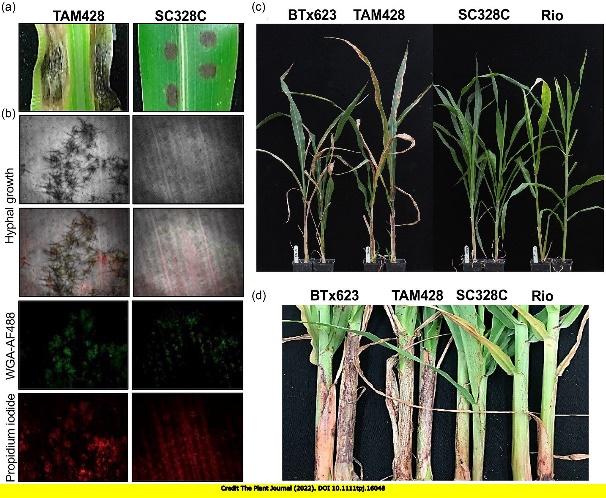 A gene discovered by a team of researchers, led by Tesfaye Mengiste, Purdue University, West Lafayette, Indiana, USA, could help strengthen sorghum’s defences against anthracnose, a grain disease that can cause yield losses of up to 50%. The discovery opens the door to breeding disease-resistant sorghum varieties that rely less on fungicides, reducing production costs for farmers, and ensuring grain yield and quality, among other things. Sorghum is the fifth most widely grown cereal crop in the world, providing consumers not only with a food source containing 12 essential nutrients but also with livestock feed and bioenergy-based material. Genetic disease resistance is the most effective and sustainable way to control sorghum anthracnose.
A gene discovered by a team of researchers, led by Tesfaye Mengiste, Purdue University, West Lafayette, Indiana, USA, could help strengthen sorghum’s defences against anthracnose, a grain disease that can cause yield losses of up to 50%. The discovery opens the door to breeding disease-resistant sorghum varieties that rely less on fungicides, reducing production costs for farmers, and ensuring grain yield and quality, among other things. Sorghum is the fifth most widely grown cereal crop in the world, providing consumers not only with a food source containing 12 essential nutrients but also with livestock feed and bioenergy-based material. Genetic disease resistance is the most effective and sustainable way to control sorghum anthracnose.
Anthracnose resistance can be temperature dependent, which can make the sorghum crop susceptible to infection when temperatures rise above a certain threshold. Sorghum plants carrying a resistance gene, known as “ANTRACNOSIS RESISTANCE GENE 2,” successfully resisted the fungus even when greenhouse temperatures were raised to 100oF (~37.8oC). Researchers concluded that these results significantly advance our understanding of how sorghum detects fungal pathogens, and they open the door to the development of new disease resistance against cereal plant pathogens. The results open avenues for resistance breeding and dissecting mechanisms of resistance and thus hold enormous potential. With the anthracnose resistance gene 2(ARG2)’s discovery, scientists now have a key to unlocking a fuller understanding of how the mechanisms of anthracnose resistance work and making the best use of them as a disease defence that growers worldwide can count on.
Access the full paper at https://onlinelibrary.wiley.com/doi/10.1111/tpj.16048
3. Liquorice leaf extract is a promising plant protectant for conventional and organic agriculture
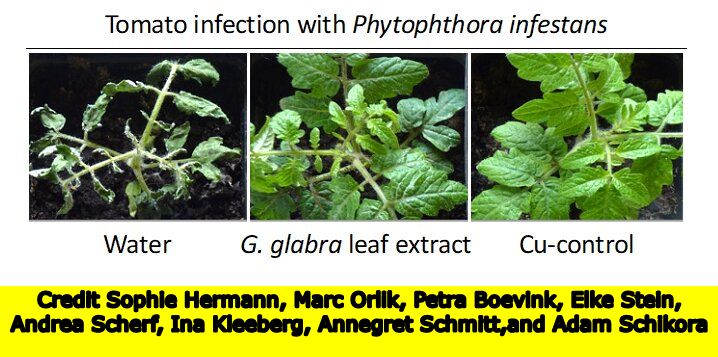
Pesticides have proven effective in protecting crops from many plant pathogens, but environmental damage to non-target organisms has created a pull between organic farming and conventional farming practices. To some extent, genetic resistance has also helped to reduce the use of pesticides; however, a large number of farmers still depend on pesticides to protect their crops. This raises the question: How can farmers and ranchers run their businesses more safely and responsibly? It seems necessary to develop alternatives to traditional and already widely used products in organic agriculture, such as copper. Such alternative products mustn’t limit the productivity and profitability of agriculture. Since the liquorice plant (Glycyrrhiza glabra) was widely used in other industries, researchers at the Trifolio-M GmbH, Lahnau, Germany, led by Adam Schikora from the Institute of Epidemiology and Pathogen Diagnostics, Braunschweig, Germany, tested its effectiveness as an insecticide and found liquorice leaf extract to be a powerful bactericidal and antifungal agent.
The pharmaceutical, cosmetic, and food industry is mainly focused on the roots of the liquorice plant. The leaves and upper parts of the plant are by-products, and they are often neglected. However, researchers show the potential of those as plant protection agents that can be used both conventionally and in organic agriculture. Using plant efficacy experiments, the researchers tested the effect of liquorice leaf extract on the virulence of common highly pathogenic bacteria in the model plant, Arabidopsis, and tomatoes. The results show that liquorice leaf extract modulates plant immune responses to pathogens, including both salicylic acid- and ethylene-based responses. Further research may help in using liquorice leaf extract as an alternative plant protection measure in the production of economically important crops.
Access the full paper at https://apsjournals.apsnet.org/doi/10.1094/PDIS-12-21-2813-RE
4. Scientists exploit genetic mutation to accelerate the plant breeding process
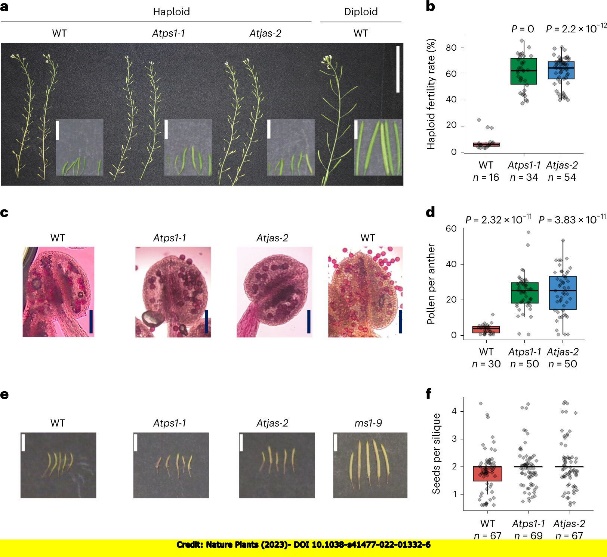
Pure lines are plants that “breed true” or produce sexual offspring that closely resemble their parents. By crossing pure lines, a uniform population of F1 hybrid seeds can be produced with predictable characteristics. The use of “doubled haploid” (DH) genetics has become one of the basic technologies underpinning modern corn breeding. The haploid plant’s single genome is then doubled through a chemical process which accelerates the development of genetically pure inbred lines. Siddique Aboobucker and colleagues at the Iowa State University, Ames, USA, discovered a mutation that restores male fertility in haploids without the use of colchicine. The researchers tested the idea on Arabidopsis thaliana.
Haploid female fertility occurs naturally to some extent in plants. However, the lack of haploid male fertility is a bottleneck for producing pure lines. Researchers show that mutations in parallel spindle genes are sufficient to restore haploid male fertility in Arabidopsis without affecting haploid female fertility. “Using this mutation to overcome the male fertility problem in haploid plants has great promise to overcome the resource-intensive protocols currently in place for artificial genome doubling methods to obtain DH lines,” says Lübberstedt, one of the authors. The procedure can simplify the production of developing genetic pure lines and thus speed up the plant breeding process.
Access the abstract at https://www.nature.com/articles/s41477-022-01332-6
5. Keanumycin, a newly identified active ingredient from bacteria, could help protect plants

Scientists are always looking for natural products that help fight insects and diseases and reduce the use of chemical products to control them. Sebastian Götze and colleagues from the Department of Paleobiotechnology at the Leibniz Institute for Natural Product Research and Infectious Biology at the Hans Knöll Institute in Jena, Germany, discovered that bacteria of the genus Pseudomonas produce a powerful antimicrobial natural product. Keanomycins, a group of natural products recently discovered in bacteria, are effective against the plant pest, Botrytis cinerea, which triggers grey mold and causes huge crop losses every year. The active substance also inhibits fungi dangerous to humans, such as Candida albicans.
The fact that researchers have now discovered a new active ingredient in bacteria of the genus Pseudomonas is no accident. Scientists have found biosynthetic genes for the recently discovered natural products keanomycin A, B, and C in the bacterial genome. This group of natural products belongs to non-ribosomal lipopeptides with soap-like properties. Together with colleagues from the Leibniz-HKI biopilot plant, the researchers managed to isolate one of the keanomycins and carried out further experiments. The researchers suspected that keanomycins might also kill fungi because they are somewhat similar to amoebae. According to the tests carried out so far, the natural product is not very toxic to human cells and is effective against fungi even at very low concentrations. More tests need to be carried out on crop plants to establish the potential of this product.
Access the abstract at https://pubs.acs.org/doi/10.1021/jacs.2c11107
6. New finding could lead to better use of fungicides to protect rice crops
Each year, the fungal pathogen, Magnaporthe oryzae, attacks and kills plants that account for 10-35% of the world’s rice crop. The fungus, which plagues rice cultivation worldwide, has been found to enter plant cells in a way that makes them vulnerable to simple chemical inhibitors. This discovery could lead to new fungicides that reduce the significant annual loss of rice and other valuable cereal crops.  Biochemists at the University of California, Berkeley, led by Michael Marletta, discovered that the fungus secretes an enzyme [polysaccharide monooxygenase (MoPMO9A)] that makes holes in the hard outer layer of rice leaves. Because the enzyme is hidden on the surface of the rice leaf, a simple spray can effectively destroy the enzyme’s ability to digest the plant walls.
Biochemists at the University of California, Berkeley, led by Michael Marletta, discovered that the fungus secretes an enzyme [polysaccharide monooxygenase (MoPMO9A)] that makes holes in the hard outer layer of rice leaves. Because the enzyme is hidden on the surface of the rice leaf, a simple spray can effectively destroy the enzyme’s ability to digest the plant walls.
The PMO enzyme breaks down cellulose-cereal-derived mixed (1→3, 1→4)-β-D-glucans (MBG) into smaller pieces, making the polysaccharide susceptible to other enzymes, such as cellulases, and accelerates the breakdown of plant fibres. MoPMO9A substrate specificity and domain architecture are different from previously described AA9 PMOs. These results, including the analysis of gene ontology, support a role for MoPMO9A in MBG degradation during plant infection. Consistent with this analysis, the deletion of MoPMO9A results in reduced pathogenicity. Based on the importance of polysaccharide monooxygenase in plant infection, it may be a valuable target for the development of new chemicals, which can be used at much lower doses than existing fungicides and have less potential environmental impact. It could also be a target for completely chemical-free approaches, such as gene silencing. Work should now focus on developing inhibitors of this particular PMO that can defeat rice blast, and it can also explore how it can be used in other plants.
Access the abstract at https://www.pnas.org/doi/10.1073/pnas.2215426120
7. Applying biochar to the soil can offer sustainability benefits, says a study
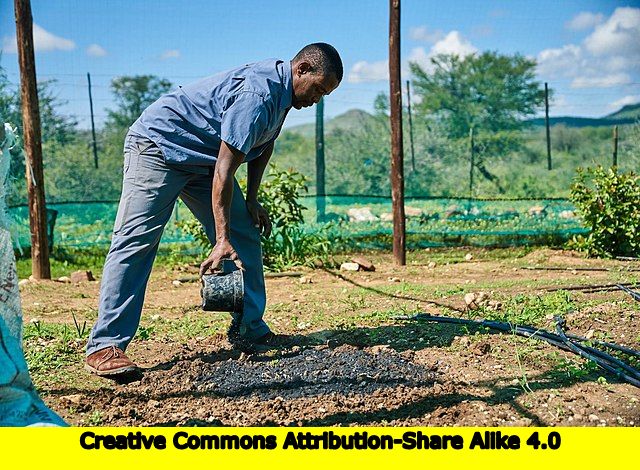 Biochar—a coal-like substance made by burning organic material, such as agricultural and forestry waste—has been part of traditional human agricultural activity for centuries. However, this practice disappeared for many reasons, including its possible role in air pollution. With the changing climate scenario, biochar conversion has been proposed as a promising solution to reduce agricultural greenhouse gas (GHG) emissions and improve crop sustainability. However, the net GHG potential of biochar remains uncertain, arising from conflicting results from field and laboratory experiments. Wei Ren at the University of Connecticut, Storrs, USA, see the potential of using biochar as a new sustainable practice. His group carried out a metanalysis of 9970 published observational data derived from 592 peer-reviewed papers to analyse its potential as a climate-smart agricultural practice.
Biochar—a coal-like substance made by burning organic material, such as agricultural and forestry waste—has been part of traditional human agricultural activity for centuries. However, this practice disappeared for many reasons, including its possible role in air pollution. With the changing climate scenario, biochar conversion has been proposed as a promising solution to reduce agricultural greenhouse gas (GHG) emissions and improve crop sustainability. However, the net GHG potential of biochar remains uncertain, arising from conflicting results from field and laboratory experiments. Wei Ren at the University of Connecticut, Storrs, USA, see the potential of using biochar as a new sustainable practice. His group carried out a metanalysis of 9970 published observational data derived from 592 peer-reviewed papers to analyse its potential as a climate-smart agricultural practice.
The group assessed whether this sustainable agricultural practice could be climate-sustainable in terms of food production, soil health, and environmental sustainability. They also attempted to measure the associated water and nutrient footprints and opportunities to promote climate change resilience. Their results show that biochar, along with other practices, can help farmers sustain food production while reducing GHG emissions and reducing nitrogen leaching and conserving groundwater. “However, we must consider the use of biochar together with other traditional sustainable nutrient management and irrigation practices in different areas, taking into account different climates,” says Ren. Studies show that tree-derived biochar can significantly reduce nitrous oxide emissions, which are almost 300 times more effective than carbon dioxide in terms of its global warming potential. These findings provide a comprehensive view that biochar amendment has very high potential as a viable climate-smart agricultural practice that can help in the partial achievement of multiple sustainable development goals.
Access the abstract at https://www.sciencedirect.com/science/article/abs/pii/S1364032122009236?via%3Dihub
News:
1. Phosphorus shortage could affect worldwide crop yields
 Although phosphorus is an essential part of plant metabolism and growth, its future supply under atmospheric carbon dioxide concentrations is uncertain. Lack of this essential nutrient can lead to lower yields, especially in poorer countries. An international team of researchers, led by Chunwu Zhu of the Chinese Academy of Sciences, Nanjing, China, suggests that, under future carbon scenarios, rice production could decline sharply, especially in poor countries, without supplemental phosphorus fertilizers. The study also indicates that the decrease in phosphorus can be explained by the production of organic phosphorus in the soil, which is not readily available to plants, and increased removal by crop harvesting. The findings further suggest that increases in plant phosphorus changes from biological, biochemical, and chemical phosphorus as a result of anthropogenic changes are not sufficient to compensate for decreases in plant phosphorus because of long-term elevated CO2 exposure.
Although phosphorus is an essential part of plant metabolism and growth, its future supply under atmospheric carbon dioxide concentrations is uncertain. Lack of this essential nutrient can lead to lower yields, especially in poorer countries. An international team of researchers, led by Chunwu Zhu of the Chinese Academy of Sciences, Nanjing, China, suggests that, under future carbon scenarios, rice production could decline sharply, especially in poor countries, without supplemental phosphorus fertilizers. The study also indicates that the decrease in phosphorus can be explained by the production of organic phosphorus in the soil, which is not readily available to plants, and increased removal by crop harvesting. The findings further suggest that increases in plant phosphorus changes from biological, biochemical, and chemical phosphorus as a result of anthropogenic changes are not sufficient to compensate for decreases in plant phosphorus because of long-term elevated CO2 exposure.
Access the abstract at https://www.nature.com/articles/s41561-022-01105-y
2. Plant discovery could lead to wider use of bee-friendly pesticides
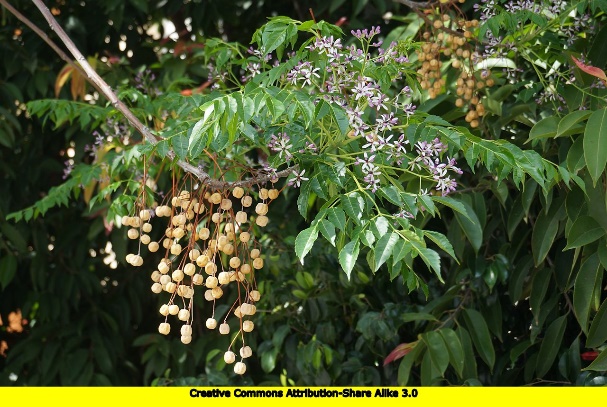 It is sad that bees are harmed by the pesticide use, because while bees are essential for pollinating crops, pesticides are also applied on those same crops. A bee-friendly pesticide may soon be cheaper and easier to make, thanks to a discovery. Certain plant families, such as citrus and mahogany, naturally produce organic chemicals called limonoids. These substances help protect plants from pests, but they do not harm bees. Like other limonoids, they must be extracted directly from the plant that produces them, in limited quantities. Researchers, led by Anne Osbourn at the John Innes Center, UK, mapped the genome of Chinaberry (Melia azedarach), a member of the mahogany family (Note: it belongs to the same family as Azadirachta indica, Meliaceae), and used molecular analysis to identify enzymes in the biosynthetic pathway that the plant uses to produce azadirone. Colleagues at Stanford University, USA, led by Elizabeth Sattely, used the same technique to discover the enzymes used by citrus fruits to produce another limonoid, kihadalactone A. These results may facilitate the production of natural and unnatural limonoids with useful properties, such as plant-derived insecticides.
It is sad that bees are harmed by the pesticide use, because while bees are essential for pollinating crops, pesticides are also applied on those same crops. A bee-friendly pesticide may soon be cheaper and easier to make, thanks to a discovery. Certain plant families, such as citrus and mahogany, naturally produce organic chemicals called limonoids. These substances help protect plants from pests, but they do not harm bees. Like other limonoids, they must be extracted directly from the plant that produces them, in limited quantities. Researchers, led by Anne Osbourn at the John Innes Center, UK, mapped the genome of Chinaberry (Melia azedarach), a member of the mahogany family (Note: it belongs to the same family as Azadirachta indica, Meliaceae), and used molecular analysis to identify enzymes in the biosynthetic pathway that the plant uses to produce azadirone. Colleagues at Stanford University, USA, led by Elizabeth Sattely, used the same technique to discover the enzymes used by citrus fruits to produce another limonoid, kihadalactone A. These results may facilitate the production of natural and unnatural limonoids with useful properties, such as plant-derived insecticides.
Access the abstract at https://www.science.org/doi/10.1126/science.adf1017
3. Farming more seaweed to be food, feed, and fuel
 The expansion of agriculture to meet the growing food and material needs of humanity is a major cause of land-use change, exacerbating climate change and loss of biodiversity. Sea-grown algae biomass can help reduce the demand for crops and reduce greenhouse gas emissions from agriculture by providing a substitute or supplement for food. Research, led by Scott Spillias at the University of Queensland, Australia, has shown that expanding global seaweed farming could help tackle the planet’s challenges of food security, biodiversity loss, and climate change. The researchers say that expanding algae farming could help reduce demand on farms and reduce agricultural greenhouse gas emissions globally by up to 2.6 billion tonnes of CO2 equivalent per year. Using a global biosphere management model, the researchers mapped opportunities to grow more than 34 commercially important algae species. “In one scenario, where we replaced 10% of human consumption worldwide with algae products, 110 million hectares of land could be prevented from being developed for agriculture,” Spillias said.
The expansion of agriculture to meet the growing food and material needs of humanity is a major cause of land-use change, exacerbating climate change and loss of biodiversity. Sea-grown algae biomass can help reduce the demand for crops and reduce greenhouse gas emissions from agriculture by providing a substitute or supplement for food. Research, led by Scott Spillias at the University of Queensland, Australia, has shown that expanding global seaweed farming could help tackle the planet’s challenges of food security, biodiversity loss, and climate change. The researchers say that expanding algae farming could help reduce demand on farms and reduce agricultural greenhouse gas emissions globally by up to 2.6 billion tonnes of CO2 equivalent per year. Using a global biosphere management model, the researchers mapped opportunities to grow more than 34 commercially important algae species. “In one scenario, where we replaced 10% of human consumption worldwide with algae products, 110 million hectares of land could be prevented from being developed for agriculture,” Spillias said.
For more, see https://phys.org/news/2023-01-farming-seaweed-food-fuel.html?utm_source=nwletter&utm_medium=email&utm_campaign=daily-nwletter
Access the abstract at https://www.nature.com/articles/s41893-022-01043-y
4. An effort in the US aims to make organic farming a viable prospect
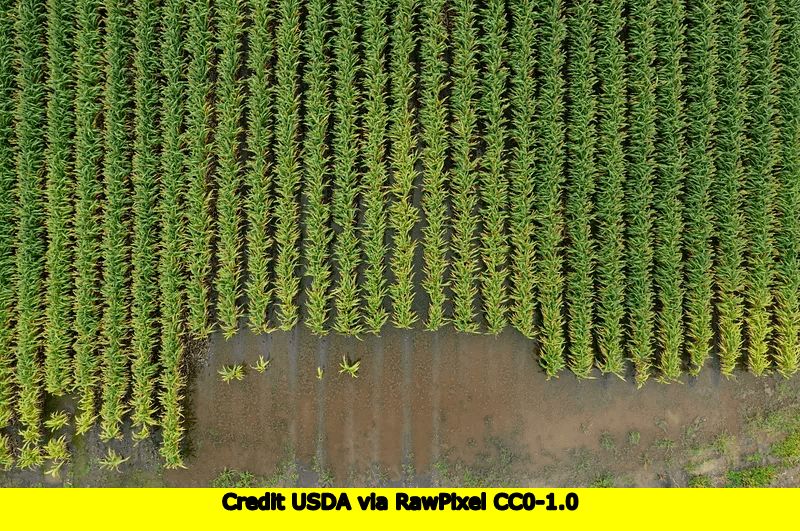
In the USA, converting to organic farming is not cheap. Farmland must stop using industrial-strength pesticides and fertilizers on land for three years before it can meet the U.S. Department of Agriculture’s standard for organic farming. Typically, during that period, the land is used as pasture. The upside is that consumers are willing to pay more for organically grown food. For organic farming to catch on, young people will have to get involved in it. But most cannot afford to do so, owing to the high cost of agricultural land and the three-year wait before land can be certified as organic ‘ A company called Farmland (which has certified land) leases about two-thirds of its land and farms the other third itself. Investors in companies such as Farmland are essentially supplying farmers with the “Office buildings” they need to do organic farming. Thus, it is possible to have many farms under one owner. This allows putting into practice some new ideas to increase production. For example, on plots that Farmland operates itself, varieties of blueberries that ripen at different times were planted assuring a steady flow of berries. Another example is that of tomatoes, which cannot be grown on the same plot for more than two years, owing to the risk of soil-borne disease. So tomato farmers can stay busy every year by going back and forth between using their property and using some of Farmland’s land.
For more, see https://geneticliteracyproject.org/2023/02/02/viewpoint-going-organic-isnt-cheap-what-does-it-cost-farmers-to-switch-from-conventional-farming-to-organic/ and https://www.nytimes.com/2023/01/27/opinion/investing-profitable-organic-farming.html (Needs subscription)
5. Mushrooms emerge from the shadows in pesticide-free production push
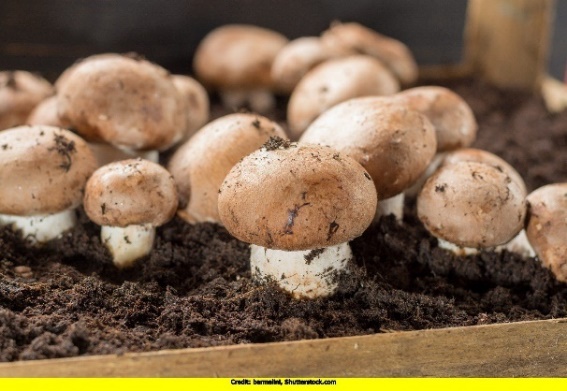 Researchers at a BIOSCHAMP project in Norway, Agnieszka Jasinska and Ketil Stoknes, plan to develop a new product for growing mushrooms, which could reduce the use of pesticides by 90% while reducing the industry’s reliance on peat. BIOSCHAMP aims to create a low-peat sustainable coating for cultivated mushrooms made from renewable materials sourced close to current mushroom production. Although commercial-level mushroom cultivation stopped in Norway in the early 2000s, because it could not compete with other countries, the BIOSCHAMP project VegWaMus CirCrop showed that Norwegian mushroom production can have a sustainable future. It launches a series of new ideas, including expanding the production of the biogas plant from food waste from buttons to oysters. They plan to produce mushroom-growing starter blocks for farmers, growers, and greenhouse owners who may want to diversify their mushroom season. Against the backdrop of the increasing rate of food waste and the need to keep production local, scientists are investigating mushroom cultivation in Norway.
Researchers at a BIOSCHAMP project in Norway, Agnieszka Jasinska and Ketil Stoknes, plan to develop a new product for growing mushrooms, which could reduce the use of pesticides by 90% while reducing the industry’s reliance on peat. BIOSCHAMP aims to create a low-peat sustainable coating for cultivated mushrooms made from renewable materials sourced close to current mushroom production. Although commercial-level mushroom cultivation stopped in Norway in the early 2000s, because it could not compete with other countries, the BIOSCHAMP project VegWaMus CirCrop showed that Norwegian mushroom production can have a sustainable future. It launches a series of new ideas, including expanding the production of the biogas plant from food waste from buttons to oysters. They plan to produce mushroom-growing starter blocks for farmers, growers, and greenhouse owners who may want to diversify their mushroom season. Against the backdrop of the increasing rate of food waste and the need to keep production local, scientists are investigating mushroom cultivation in Norway.
For more, see
6. Colombia, a biodiversity hotspot, shows the way to balance development with conservation
 Plants and animals do not respect legal boundaries because they ignore the customs of different jurisdictions. Stanford University-led research, by Alejandra Echeverri and colleagues, highlights how policies in forestry, agriculture, and other sectors can be aligned to manage biodiversity in a more coordinated and effective way. The first-of-its-kind analysis focuses on Colombia, one of the world’s most biodiverse countries, and found that biodiversity is managed through 200 different policies covering various ecosystems, conservation approaches, scales, actors, and threats. “We were surprised to see biodiversity driven by policies aimed at many other things, such as poverty alleviation and ending the civil conflict,” says Echeverri. The country’s biodiversity is threatened by agriculture, mining, and invasive species, making it an ideal place to study how politics affects biodiversity management. As the country developed, policies aimed at eradicating poverty and combating the ongoing civil war included biodiversity conservation as a secondary goal. The integration of biodiversity policy in some sectoral policies, such as climate change, poverty, and pollution, has become more common in the last decade. The result of the analysis indicates an increased need for effective coordination between different sectors and actors when new policy combinations are influenced and implemented.
Plants and animals do not respect legal boundaries because they ignore the customs of different jurisdictions. Stanford University-led research, by Alejandra Echeverri and colleagues, highlights how policies in forestry, agriculture, and other sectors can be aligned to manage biodiversity in a more coordinated and effective way. The first-of-its-kind analysis focuses on Colombia, one of the world’s most biodiverse countries, and found that biodiversity is managed through 200 different policies covering various ecosystems, conservation approaches, scales, actors, and threats. “We were surprised to see biodiversity driven by policies aimed at many other things, such as poverty alleviation and ending the civil conflict,” says Echeverri. The country’s biodiversity is threatened by agriculture, mining, and invasive species, making it an ideal place to study how politics affects biodiversity management. As the country developed, policies aimed at eradicating poverty and combating the ongoing civil war included biodiversity conservation as a secondary goal. The integration of biodiversity policy in some sectoral policies, such as climate change, poverty, and pollution, has become more common in the last decade. The result of the analysis indicates an increased need for effective coordination between different sectors and actors when new policy combinations are influenced and implemented.
Access the abstract at https://www.nature.com/articles/s41559-023-01983-4
7. International IPM program drives sustainable management of tomato leafminer
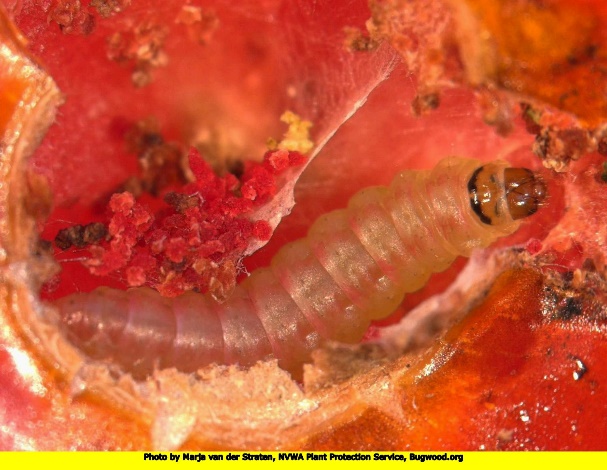 The whitefly, Tuta absoluta, is one of the world’s most destructive phytophagous species that affect tomato plants and fresh tomatoes, causing large yield losses, especially if no control strategies are implemented. From America, where it originated, it penetrated the production sites of Europe, Asia, and Africa. Researchers from the Center for Agriculture and Bioscience International (CABI) and several Latin American universities, led by Jelitza Colmenárez of CABI Latin America Brazil, are conducting detailed case studies on the sustainable management of T. absoluta through CABI’s Plantwise program. During its 10-year implementation, more than 3,700 herbal clinics operated in 3 countries around the world, where herbalists provided diagnostic and treatment advice for all problems and crops, benefiting farmers in need of help with plant pests and crop diseases. During the implementation of Plantwise, the technicians who provided this advice to the farmers in the plant clinics also received integrated pest management training; they thus became familiar with more economical ways to manage the most important pests. As demonstrated in Bolivia and Costa Rica, the Plantwise programme led to significant changes in the way farmers control pests, including T. absoluta, based on replacing or supplementing chemical control with more sustainable strategies, thanks in part to recommendations from plant doctors.
The whitefly, Tuta absoluta, is one of the world’s most destructive phytophagous species that affect tomato plants and fresh tomatoes, causing large yield losses, especially if no control strategies are implemented. From America, where it originated, it penetrated the production sites of Europe, Asia, and Africa. Researchers from the Center for Agriculture and Bioscience International (CABI) and several Latin American universities, led by Jelitza Colmenárez of CABI Latin America Brazil, are conducting detailed case studies on the sustainable management of T. absoluta through CABI’s Plantwise program. During its 10-year implementation, more than 3,700 herbal clinics operated in 3 countries around the world, where herbalists provided diagnostic and treatment advice for all problems and crops, benefiting farmers in need of help with plant pests and crop diseases. During the implementation of Plantwise, the technicians who provided this advice to the farmers in the plant clinics also received integrated pest management training; they thus became familiar with more economical ways to manage the most important pests. As demonstrated in Bolivia and Costa Rica, the Plantwise programme led to significant changes in the way farmers control pests, including T. absoluta, based on replacing or supplementing chemical control with more sustainable strategies, thanks in part to recommendations from plant doctors.
For more, see https://entomologytoday.org/2023/01/25/international-ipm-program-plantwise-sustainable-management-tomato-pest-tuta-absoluta/
Access the full paper at
https://academic.oup.com/jipm/article/13/1/15/6586048?login=false
8. A ‘New Green Revolution’ is brewing—just in time, as the world population breaks past the 8 billion mark
There are signs of a new green revolution in India, a good augury for the whole world because of its need to feed 8 billion people.  Gurjeet Singh Mann, an Indian farmer, says, “I have seen the impact in my area in northern India, where I have worked on my family farm for over four decades and currently grow rice and wheat.” Mann is a farmer who uses new technology, including genetically modified crops, and helps fellow farmers and young farmers with farming techniques.
Gurjeet Singh Mann, an Indian farmer, says, “I have seen the impact in my area in northern India, where I have worked on my family farm for over four decades and currently grow rice and wheat.” Mann is a farmer who uses new technology, including genetically modified crops, and helps fellow farmers and young farmers with farming techniques.
Without more land to produce food, we must do more with what we have—and with more than 8 billion people in the world, that means more food must be grown on less land than ever before. In the 1960s, the world’s population passed 3 billion—and many experts were concerned about the ability of farmers to improve their production and continue. “Throughout my farming career, I’ve seen technology change everything,” said Mann. It all starts with the best seeds, but we also have other technological options: climate-smart agriculture requires better machinery, from large field harvesters to small and micro harvesters, which most farmers can use to map it to small drones for better monitoring; micro-irrigation for efficient water supply during climate change; improved weather forecasting to help us make planting decisions; and plant protection products that fight weeds, pests, and diseases.
Events (October 2023):
1. ICEAST 2023: International Conference on Ecological Agricultural Systems  and Technologies
and Technologies
02-03 October 2023, Tbilisi, Georgia
For more, see https://waset.org/ecological-agricultural-systems-and-technologies-conference-in-october-2023-in-tbilisi
2. ICOCPSA 2023: International Conference on Organic Crop Production and Sustainable Agriculture

18-19 October 2023, Rome, Italy
For more, see https://waset.org/organic-crop-production-and-sustainable-agriculture-conference-in-october-2023-in-rome
3. ICSAFSN 2023: International Conference on Sustainable Agriculture, Food Security and Nutrition

21-22 October 2023, Kathmandu, Nepal
For more, see https://waset.org/sustainable-agriculture-food-security-and-nutrition-conference-in-october-2023-in-kathmandu
4. ICCCMAS 2023: International Conference on Climate Change, Mitigation and Adaptation Strategies

25-26 October 2023, Barcelona, Spain
For more, see https://waset.org/climate-change-mitigation-and-adaptation-strategies-1-conference-in-october-2023-in-barcelona
5. ICAFF 2023: International Conference on Agroforestry and Forest Farming

28-29 October 2023, Lisbon, Portugal
For more, see https://waset.org/agroforestry-and-forest-farming-conference-in-october-2023-in-lisbon
6. ICPVM 2023: International Conference on Plant Virology and Microbiology

28-29 October 2023; Paris, France
For more, see https://waset.org/plant-virology-and-microbiology-conference-in-october-2023-in-paris
Other Topics of Interest
1. Nutrient uptake in citrus rootstock affected by Huanglongbing
Access the full paper at https://journals.ashs.org/hortsci/view/journals/hortsci/58/1/article-p40.xml
2. How salmon feed flowers and flourishing ecosystems: Study
Access the full paper at https://royalsocietypublishing.org/doi/10.1098/rsos.221008
3. Savanna plants show high physiological resilience to extreme drought
4. Tracing the evolution of wheat spikes since the Neolithic revolution
5. Cinnamon and cognitive function: a systematic review of preclinical and clinical studies
6. UK: International Plant Health Conference 2022 report published
For more, see https://www.hortidaily.com/article/9501793/uk-international-plant-health-conference-2022-report-published/
Access the Conference report at https://www.fao.org/3/cc3894en/cc3894en.pdf
7. How urban gardens are good for ecosystems and Humans
Access the full paper at https://onlinelibrary.wiley.com/doi/10.1111/ele.14146
8. The past as a lens for biodiversity conservation on a dynamically changing planet
For more, see https://www.pnas.org/doi/10.1073/pnas.2201950120
9. How does biodiversity change globally? Detecting accurate trends may be currently unfeasible
For more, see https://phys.org/news/2023-02-biodiversity-globally-accurate-trends-unfeasible.html
10. Two proteins join forces to make flowers
For more, see https://phys.org/news/2023-02-proteins.html?utm_source=nwletter&utm_medium=email&utm_campaign=daily-nwletter
Access the abstract at https://www.nature.com/articles/s41477-022-01336-2
11. A global comparison shows that soil transplantation boosts nature restoration
Access the full paper at https://besjournals.onlinelibrary.wiley.com/doi/10.1111/1365-2664.14364
12. Using CRISPR-Cas9 to knock out the asparagine gene in wheat to reduce cancer risk
Access the full paper at https://onlinelibrary.wiley.com/doi/epdf/10.1111/pbi.14026
13. The potentials and impacts of plant-based meat alternatives
For more, see https://seedworld.com/the-potentials-and-impacts-of-plant-based-meat-alternatives/
Access the full paper at https://www.mdpi.com/2072-6643/15/2/452
14. Scientists discover new species of Fabaceae
Access the full paper at https://phytokeys.pensoft.net/article/96916/
15. Arming vegetables with anti-inflammatory properties using plant pigments
Access the abstract at https://onlinelibrary.wiley.com/doi/10.1002/bit.28335
16. Trees can be weeds too
For more, see https://theconversation.com/trees-can-be-weeds-too-heres-why-thats-a-problem-182599
17. Farming in arid areas depletes China’s water
For more, see https://www.science.org/doi/10.1126/science.adg4780
18. Palm oil is not that bad (anymore)
For more, see https://www.vox.com/science-and-health/2023/2/2/23568192/palm-oil-deforestation-sustainable
19. Researchers develop the first nanotube sensors capable of detecting and distinguishing gibberellin plant hormones
20. Can we increase the carbon content of agricultural soils?
Access the full paper at https://www.sciencedirect.com/science/article/pii/S0016706122003299?via%3Dihub
21. The long-standing mystery of mRNAs resolved
Access the full paper at https://www.nature.com/articles/s41586-022-05668-z
22. Veganism may not save the planet: Study suggests limited meat consumption better for the environment, animals
Access the full paper at https://journals.librarypublishing.arizona.edu/jpe/article/id/3052/
23. How microbes die influences soil carbon content, study finds
Access the abstract at https://www.nature.com/articles/s41561-022-01100-3
24. Unearthing the impact of moisture on soil carbon processes
25. Researchers uncover how photosynthetic organisms regulate and synthesize ATP
For more, see https://phys.org/news/2023-02-uncover-photosynthetic-atp.html?utm_source=nwletter&utm_medium=email&utm_campaign=daily-nwletter
Access the abstract at https://www.pnas.org/doi/10.1073/pnas.2218187120
26. New angle on theory explaining species diversity in rainforest trees
Access the abstract at https://www.nature.com/articles/s41586-023-05717-1
27. Fungal enzymes developed with microfluidics may be new organic tool in fight against crop-killers
Access the full paper at https://www.nature.com/articles/s41378-022-00456-1
28. Researchers put plant protein mechanisms into bacteria to help move forward 50 years of effort
29. Natural seed banks are detrimental to biodiversity, according to new study
Access the full paper at https://besjournals.onlinelibrary.wiley.com/doi/10.1111/1365-2745.14074
30. Why this promising biofuel crop takes a summer break
For more, see https://phys.org/news/2023-01-biofuel-crop-summer.html?utm_source=nwletter&utm_medium=email&utm_campaign=daily-nwletter
Access the full paper at https://www.frontiersin.org/articles/10.3389/fpls.2022.1023571/full
31. Examining lentil yield and nitrogen fixation response to inoculant and fertilizer
Access the full paper at https://landresources.montana.edu/fertilizerfacts/html/FF81.html
32. How a single-gene change led to a new species of monkeyflower
Access the abstract at https://www.science.org/doi/10.1126/science.adf1323
33. Using spiders as environmentally friendly pest control
Access the full paper at https://www.mdpi.com/2075-4450/14/1/34
34. Plant diversity may never fully recover from agriculture without a helping hand
Access the full paper at https://besjournals.onlinelibrary.wiley.com/doi/10.1111/1365-2745.14063
35. How Nepal regenerated its forests
For more, see https://earthobservatory.nasa.gov/images/150937/how-nepal-regenerated-its-forests
Access the full paper at https://www.mdpi.com/2072-4292/13/11/2131
